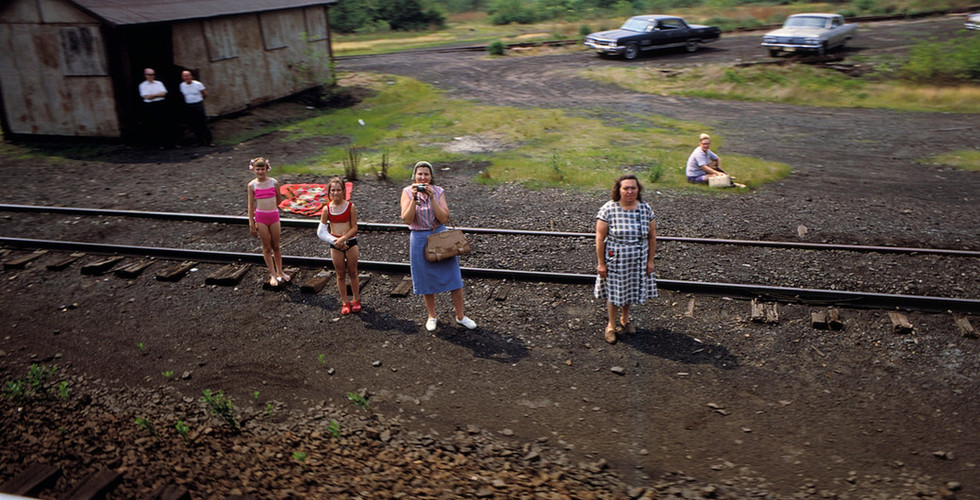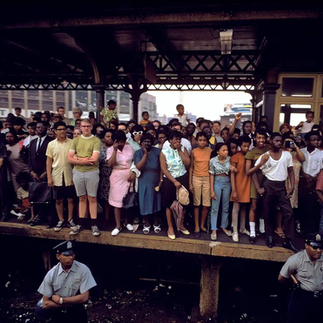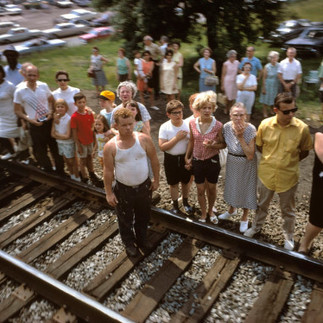The Funeral Train of Robert F. Kennedy: A Journey of Sorrow Captured Through a Nation’s Lens

The image of a funeral train rolling through the American heartland is both sombre and symbolic. One such train—the one that carried the body of Robert F. Kennedy—became an unforgettable emblem of a nation in mourning. This iconic moment in American history, which unfolded on June 8, 1968, was documented in a series of poignant photographs that still resonate with profound emotional weight.
As the train made its way from New York City to Washington, D.C., to deliver the senator’s body to Arlington National Cemetery, thousands of Americans lined the tracks to pay their respects. RFK, a figure of great hope and promise, had been assassinated just days earlier, and his death, following that of his brother President John F. Kennedy, cast a long, dark shadow over the country. The crowds who gathered at the tracks bore witness to this grief, their faces etched with sorrow, reflecting the profound sense of loss that pervaded the nation.
What makes the photographs of this funeral train particularly moving is their depiction of the silent, shared mourning that crossed the racial and socio-economic divides of the 1960s. The train, moving slowly through the landscape, became a focal point for national reflection, and the scenes captured along the way are now etched into the collective memory of America. Photographers working for Life magazine, along with other media outlets, snapped images of ordinary citizens standing in quiet tribute—men, women, and children who stood in the summer heat to say a final farewell to RFK.
Perhaps the most famous image is the one taken by photographer Paul Fusco. Aboard the funeral train, Fusco aimed his camera outward, capturing the people standing along the tracks. His photos, shot through a window blurred with speed, captured a wide array of Americans—from factory workers, to families, to African American mourners, all standing in dignified silence. Some saluted, some held signs, while others simply looked on in quiet reverence. These images not only documented the funeral procession but also told a broader story of a divided nation in a rare moment of unity.
The train journey, meant to be around four hours, stretched closer to eight as it crawled through the crowds of mourners. What stands out about Fusco’s photos is that they seem almost timeless—the people in them, frozen in their grief, look almost ghostly as they are blurred by the train’s motion. Despite the 1960s being a time of immense political upheaval, these photos show how Kennedy’s death brought together a cross-section of the country in their shared heartbreak.
But it wasn’t just Fusco’s photos that immortalised this moment in history. The American photographer and painter Richard Avedon also captured striking images from the funeral, albeit in a different manner. His work focused more on intimate portraits, capturing the raw emotion of individuals as they grieved RFK’s passing. While Fusco’s work gave a sweeping view of the nation in mourning, Avedon’s lens brought the sorrow into sharper focus, narrowing in on the faces of those who had felt RFK’s loss personally.
These photographs are more than just historical records; they are powerful symbols of the emotional turbulence of 1968. Kennedy’s death came on the heels of Martin Luther King Jr.’s assassination, amid riots, protests, and a growing schism in American society over civil rights and the Vietnam War. Yet, for a brief moment, as the funeral train passed, these divisions seemed to melt away, replaced by a collective expression of sorrow and loss.
Fusco’s images, in particular, serve as a reminder of the humanity that emerged during this period of tragedy. His photos do not depict the celebrities or political figures of the time, but rather, the ordinary people who had been touched by Kennedy’s vision for America—a vision that ended abruptly with his death but lived on in their memories.
The legacy of RFK’s funeral train photography extends beyond the immediate historical context. Fusco’s images have been displayed in exhibitions and galleries, offering new generations the chance to engage with this moment in American history. The blurry, almost impressionistic quality of these photos speaks to the way memory and grief often work—fading in detail over time but never losing their emotional impact.
Today, over half a century later, these photos continue to resonate. They evoke a time when a nation came together to honour a man who represented hope and progress in the midst of one of the most turbulent periods of modern history. The train that carried Robert F. Kennedy’s body to its final resting place also carried the weight of a nation’s grief, captured forever in the solemn faces of those who stood by the tracks, waiting to say their goodbyes.
Jack Newfield, a reporter that had been travelling with the campaign, expressed his feelings on the effect of the assassination, closing his memoir on Kennedy with:
"Now I realised what makes our generation unique, what defines us apart from those who came before the hopeful winter of 1961, and those who came after the murderous spring of 1968. We are the first generation that learned from experience, in our innocent twenties, that things were not really getting better, that we shall not overcome.
We felt, by the time we reached thirty, that we had already glimpsed the most compassionate leaders our nation could produce, and they had all been assassinated. And from this time forward, things would get worse: our best political leaders were part of memory now, not hope.
The stone was at the bottom of the hill and we were all alone."































































































